President of the Senate is a title often given to the presiding officer of a senate. It corresponds to the speaker in some other assemblies.

The prime minister of Romania, officially the prime minister of the Government of Romania, is the head of the Government of Romania. Initially, the office was styled President of the Council of Ministers, when the term "Government" included more than the Cabinet, and the Cabinet was called the Council of Ministers. The title was officially changed to Prime Minister by the 1965 Constitution of Romania during the communist regime.
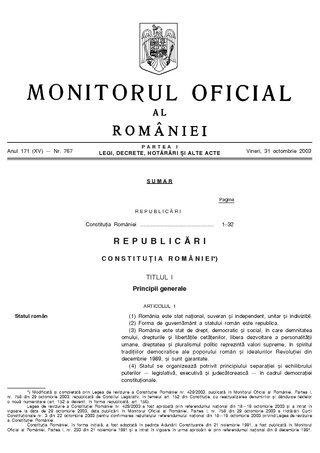
The current Constitution of Romania is the seventh permanent constitution in modern Romania's history. It is the fundamental governing document of Romania that establishes the structure of its government, the rights and obligations of citizens, and its mode of passing laws. It stands as the basis of the legitimacy of the Romanian government. Adopted on 21 November 1991, it was approved on 8 December 1991 in a national referendum and promulgated on the same day.
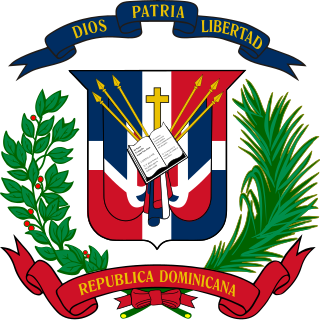
The Congress of the Dominican Republic is the bicameral legislature of the government of the Dominican Republic, consisting of two houses, the Senate and the Chamber of Deputies. Both senators and deputies are chosen through direct election. There are no term limits for either chamber.
Dissolution of a legislative assembly is the mandatory simultaneous resignation of all of its members, in anticipation that a successive legislative assembly will reconvene later with possibly different members. In a democracy, the new assembly is chosen by a general election. Dissolution is distinct on the one hand from abolition of the assembly, and on the other hand from its adjournment or prorogation, or the ending of a legislative session, any of which begins a period of inactivity after which it is anticipated that the same members will reassemble. For example, the "second session of the fifth parliament" could be followed by the "third session of the fifth parliament" after a prorogation, but the "first session of the sixth parliament" after a dissolution.
This article gives an overview of liberalism and radicalism in Romania. It is limited to liberal parties with substantial support, mainly proved by having had a representation in parliament. The sign ⇒ denotes another party in this scheme. For inclusion in this scheme it is not necessary for a party to have actually labeled itself as a liberal party.

The Senate is the upper house in the bicameral Parliament of Romania. It has 136 seats, to which members are elected by direct popular vote using party-list proportional representation in 43 electoral districts, to serve four-year terms.
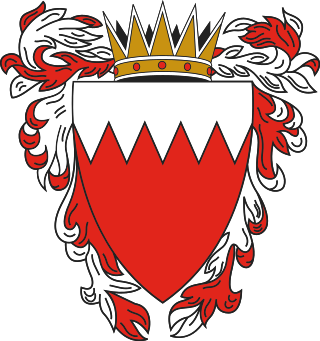
Bahrain has had two constitutions in its modern history. The first one was promulgated in 1973, and the second one in 2002.

The Parliament of Romania is the national bicameral legislature of Romania, consisting of the Chamber of Deputies and the Senate. It meets at the Palace of the Parliament in Bucharest, the capital of the country.
Article 200 was a section of the Penal Code of Romania that criminalised homosexual relationships. It was introduced in 1968, under the communist regime, during the rule Nicolae Ceaușescu, and remained in force until it was repealed by the Năstase government on 22 June 2001. Under pressure from the Council of Europe, it had been amended on 14 November 1996, when homosexual sex in private between two consenting adults was decriminalised. However, the amended Article 200 continued to criminalise same-sex relationships if they were displayed publicly or caused a "public scandal". It also continued to ban the promotion of homosexual activities, as well as the formation of gay-centred organisations.
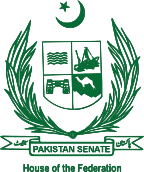
The chairman of the Senate of Pakistan is the president-chair of the Senate of Pakistan. According to the Constitution of Pakistan, the chairman is a presiding official and the Senate must choose a chairman and deputy chairman for a time interval of three years.
A senator for life is a member of the senate or equivalent upper chamber of a legislature who has life tenure. As of 2023, five Italian senators out of 205, two out of the 41 Burundian senators, one Congolese senator out of 109, and all members of the British House of Lords have lifetime tenure. Several South American countries once granted lifetime membership to former presidents but have since abolished the practice.
The Peasants' Party was a political party in post-World War I Romania that espoused a left-wing ideology partly connected with Agrarianism and Populism, and aimed to represent the interests of the Romanian peasantry. Through many of its leaders, the party was connected with Poporanism, a cultural and political trend in turn influenced by Narodnik ideas. In 1926, it united with the Romanian National Party to form the National Peasants' Party (PNȚ).

The Constitution of the Kingdom of Thailand provides the basis for the rule of law in Thailand. Since the abolition of the absolute monarchy in 1932, Thailand has had 20 charters or constitutions, an average of one roughly every four years. Many changes followed military coups, reflecting the high degree of political instability in the country. After each successful coup, military regimes abrogated the existing constitution, generally without public consultation.

The Bessarabian Peasants' Party or Moldavian National Democratic Party was an agrarian political party, active in the Kingdom of Romania and, more specifically, the region of Bessarabia. Comprising various pro-Romanian and regionalist factions that had existed within the Moldavian Democratic Republic, it was brought together by shared opposition to Bolshevik Russia and communism. The PȚB, founded in August 1918, was led by Pan Halippa and Ion Inculeț, originally representing, respectively, its right and left wings; Ion Pelivan was the co-chair.

The National Assembly of Thailand is the bicameral legislative branch of the government of Thailand. It convenes in the Sappaya-Sapasathan, Dusit District, Bangkok.
The 1866 Constitution of Romania was the fundamental law that capped a period of nation-building in the Danubian Principalities, which had united in 1859. Drafted in a short time and closely modeled on the 1831 Constitution of Belgium, then considered Europe's most liberal, it was substantially modified by Prince Carol and adopted by the Constituent Assembly. The newly installed Prince then promulgated it on 13 July [O.S. 1 July] 1866. This was done without input from the major powers, including the Ottoman Empire, which still had formal sovereignty over Romania.
The 1938 Constitution of Romania was the fundamental law of Romania from the time of its adoption until 1940. It formed the legal basis for the royal dictatorship of King Carol II. It replaced the 1923 Constitution.
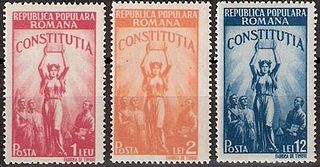
The 1948 Constitution of Romania was the first adopted after the establishment of the Communist regime, which it enshrined into law. It was modelled on the 1936 Soviet Constitution and adopted by the Great National Assembly (MAN) on April 13, 1948, being published in Monitorul Oficial the same day. The Romanian People's Republic was defined as a “unitary and sovereign people's state” that “came into being through a struggle led by the people, the working class at their head, against fascism, reaction and imperialism”.

The Landtag of Prussia was the representative assembly of the Kingdom of Prussia implemented in 1849, a bicameral legislature consisting of the upper House of Lords (Herrenhaus) and the lower House of Representatives (Abgeordnetenhaus). After World War I and the German Revolution of 1918–19 the Landtag diet continued as the parliament of the Free State of Prussia between 1921 and 1934, when it was abolished by the Nazi regime.











